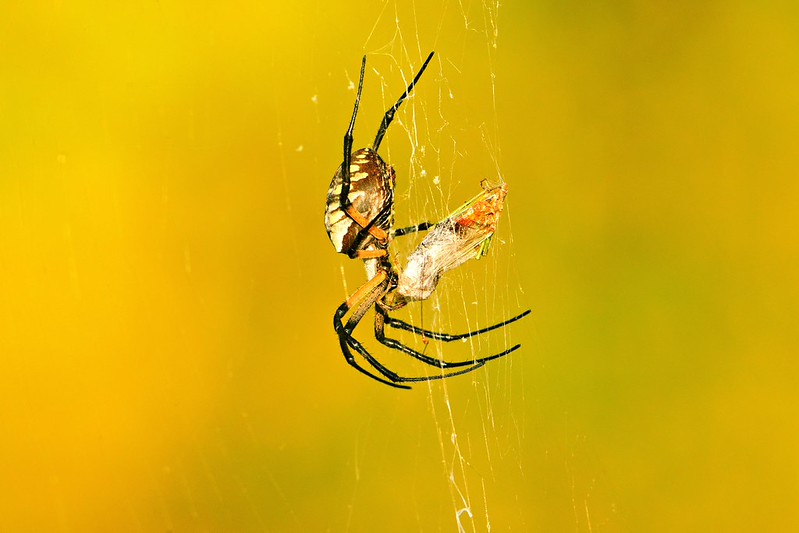Today I’m sharing an image of a garden spider doing what it does best, catching and eating an insect meal. This spider had trapped a grasshopper in its intricate orb web next to the auto tour road at Sequoyah National Wildlife Refuge in Oklahoma.

In my photo, the garden spider has already wrapped the grasshopper tightly in silk before beginning to feed. This is typical behavior for garden spiders. Once an insect gets caught in the web, the spider bites and injects venom to immobilize it. Then it wraps the prey securely in silk before feeding.
I’ve been watching and photographing this spider for several weeks from inside my truck. Its web sits close to the road, making it easy to document its daily insect-catching routine. Garden spiders are common across North America and often build webs in gardens, fields, and meadows.
Wildlife Notes
Garden spiders play an important role in controlling pest insects like mosquitoes, gnats, flies, and grasshoppers. The insects they trap become nutritious meals that fuel growth and reproduction. A single spider can eat dozens of insects each day during peak season.
They pose no danger to humans unless handled roughly. Their venom affects small insects, not people. Having these spiders around helps keep backyard pests in check.
The species in this photo appears to be a Black and Yellow Garden Spider (Argiope aurantia). It’s easy to recognize by its bold black and yellow pattern. As an orb-weaver, it constructs a circular web supported by radiating lines and spiral threads that can span nearly two feet.
If you’re interested in how these spiders rebuild after a meal, you can read my post about A Garden Spider Repairing Its Web. Watching one rebuild its delicate silk structure is just as fascinating as seeing it hunt.
Females are much larger than males. The one in this photo is likely female based on her size. After mating in late summer or fall, females lay egg sacs holding hundreds of eggs. The young spiders emerge the following spring.
Watching spiders hunt and feed is always fascinating. Every step, from the first bite to the careful wrapping, shows how efficient these predators are.
Photography Notes
I photographed this spider from inside my truck, which works well as a mobile blind at the refuge. The web hung about eight feet from the road, within range of my 500mm lens.
The bright yellow background came from the autumn foliage behind the web. It gave a warm glow that made the spider and its prey stand out. I positioned the web in early morning light so the silk threads caught the sun.
Shooting at f/6.3 kept both the spider and grasshopper sharp while blurring the background. A 1/800 second shutter speed froze any movement from light wind. ISO 500 provided enough light without adding noise.
Exposure compensation stayed at 0 because the scene balanced well on its own. The Canon EOS R7’s autofocus tracked the spider through the web’s strands easily. I used single-point AF to focus right on the spider’s body.
Camera: Canon EOS R7
Lens: Canon EF 500mm f/4L IS USM
Focal Length: 500mm
Aperture: f/6.3
Shutter Speed: 1/800 second
ISO: 500
Exposure Compensation: 0

The more Grasshoppers caught by Birds Spiders and Frogs the Fewer there will be to ruin your Garden